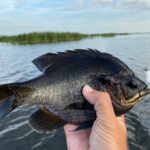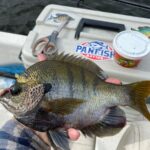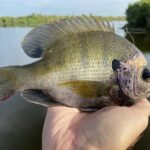Crappie are a very popular game fish throughout much of the country and are famed for their fight in the water and their taste on the plate.
But how do you tell whether the fish you just caught is a crappie or one of the other similar species?
Or, how do you know which kind of crappie you’ve caught?
In this article, I’ll tell you and show you each type of crappie, discuss the differences, and answer a few commonly asked questions.
Table of Contents
What Does a Crappie Look Like?
Crappie can be positively identified by looking at their size, body shape, and markings. Once you know how, they’re easy to identify.
Black and white crappie both have the classic sunfish oval profile, as contrasted with the torpedo-shaped body of the largemouth or smallmouth bass. They are both greenish/black on the top, shading down to silver near the belly with large eyes and an upward sloping bottom jaw.
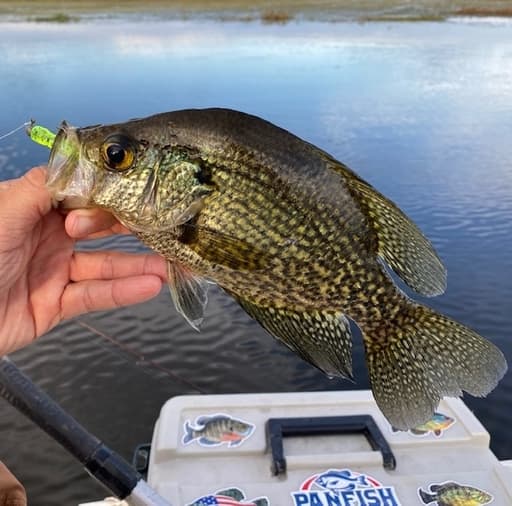
Variations in color and patterns is common. Some black crappie may appear very dark and blotchy, while others may appear silver. This is often due to environmental factors such as water quality, diet, and habitat.
The names black and white crappie might make you think that the black crappie is substantially darker than the white crappie, but this isn’t always the case. It’s darker, but not much.
At first glance, both species look a lot alike…so how do you know which one you’ve caught?
Black Crappie
Black crappie are a little bigger, a little rounder, and a little darker than white crappie. Blacks also tend to be shorter from the nose to tail than a white while also being heavier, which gives them a stockier build.
However, the easiest way to tell black crappie from white crappie is its coloration pattern. While they’re similar, the black crappie has dark spots or blotches on its side that don’t tend to make a very discernible pattern.
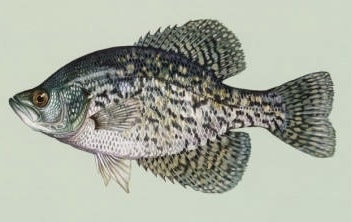
Black crappie will usually have seven or eight spines on their dorsal fin.
Some black crappie have a gene that gives them a very noticeable black stripe that runs from their top lip to their dorsal fin. It can also run under their chin.
These are called black nose crappie in some places but are just a genetic variation on black crappie, not a separate species.
White Crappie
By contrast, white crappie are somewhat smaller on average and a little bit longer and thinner.
White crappie will have five or six spines on its dorsal fin.
The pattern is where the white really stands out. Instead of the spotted sides of the black, the white has a noticeable pattern of vertical bars.
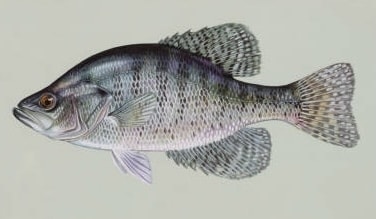
It’s important to remember that while blacks get a little bigger, the size and weight of the two species is very close.
White crappie are more comfortable with silty or cloudy water than black crappie are. In bodies of water with different water clarity, you can often see the two species segregate based on water type.
For example, If the northern half of the lake is muddy from a river flowing in, that’s where the white crappie will be, while the black crappie will likely be in cleaner or clearer water that is less turbulent.
See Also: 3 Easy Differences Between Black Crappie vs White Crappie
Hybrid Crappie
Like many species of sunfish, black and white crappie do crossbreed with each other sometimes. It happens in the wild and is also sometimes done intentionally in fish hatcheries.
The hatchery hybrids are created for stocking purposes. Black and white crappie both spawn at a tremendous rate and tend to overpopulate smaller bodies of water quickly.
The hatchery hybrids, which are half blacknose black crappie and half white crappie, breed much more slowly than either purebred species.
Blacknose blacks are used for this purpose to make the hybrids easier to identify.
Wild hybrids also occur and can be very confusing because they will show a mix of characteristics.
Wild hybrids appear to prefer to breed back into the black population, so large wild hybrid groups and catches are rare.
What Do Baby Crappie Look Like?
Baby crappie (2-5 inches in length) begin to resemble the typical body shape associated with the species. Colors will be less pronounced, with only faint markings. They will appear more silver with a lateral line and spots on the dorsal and tail fins.
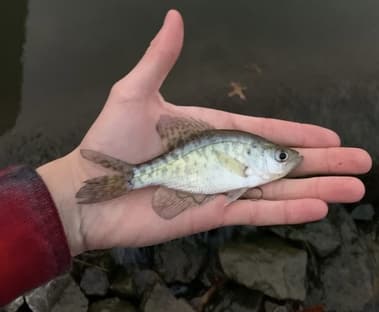
Baby crappie is a general term for any crappie that has not reached a size where they can be legally kept and cooked! Usually, this is small enough to fit in the palm of your hand, (2-5 inches).
As they get older, they take on the appearance of adult crappie and become easier to identify.
What Are Crappies Mistaken For, And How Do I Tell The Difference?
It’s fairly common for crappie to be confused with some other members of the sunfish family because of the common general body type.
They’re rarely confused with the largemouth or smallmouth bass because those bass don’t really look like sunfish even though they are.
One of the most commonly confused species is with rock bass, which have a body type closer to crappie than the other bass do. They’re fairly easy to tell apart, as rock bass have red or orange eyes.
Bluegill is another common sunfish that can be confused with crappie, but they tend to be much smaller and are brighter, rounder, and have a large black gill cover.
Most other sunfish are also smaller than crappie and tend to be much more brightly colored.
You May Also Like: What Is The Difference Between Bream and Crappie?
What Do Crappie Beds Look Like?
An important thing to be able to spot when you’re fishing for crappie is the kind of habitat that crappie like.
Unlike most species of sunfish, crappie do not actually fan out a bed in the sediment like bluegill. Instead, females deposit their eggs directly onto substrate (referred to as a nest) such as eelgrass, stump fields, hydrilla or other vegetation.
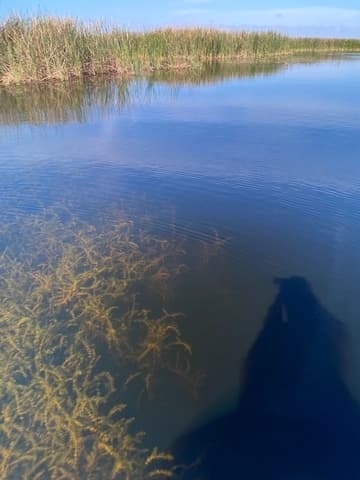
Crappie like to move into brush, fallen trees, or any kind of cover where they can hunt for a meal and be protected from predators.
A natural crappie nest can be any sheltered area with submerged weeds or brush. Fallen trees, docks, and boathouses are good, as are natural eddies and overhanging brush.
Crappie spawning nests tend to be sheltered, flat, shallow areas with vegetation, that warm-up early in the spring.
People also make all kinds of artificial crappie habitats to encourage spawning, including PVC crappie trees, which are designed to attract algae, forage fish, and eventually crappie. They are inexpensive to make and are prevent snags.
Fishermen will also throw weighted Christmas trees, citrus trees, or oak trees in the water or fell trees to hang into the water from the bank. Over time, this will create a crappie hole that can be fished for years.
What Do Crappie Look Like On A Fish Finder?
Each fish finder will show fish differently on the display screen depending on the model and technology.
On some models, this may be a fish icon you can turn on or off, on other models it may be an arc or resemble a checkmark.
I use a standard sonar Hummingbird Helix 5 and here is a large school of crappie on my fish finder:
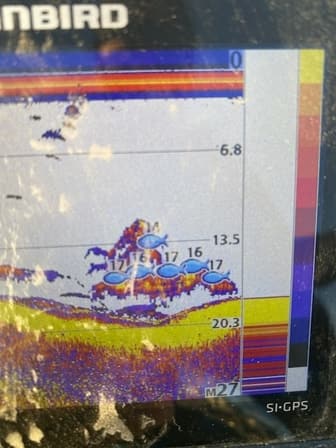
As you can see they are bunched together, with no discernible shape, however you can see clearly they are staged in about 16 feet of water and sitting about 4 feet off the bottom. This is very common with schools of crappie during the early winter months.
New fish finders like the Garmin Livescope system are able to show real-time details of fish under the surface.
These innovative sonar systems are changing the way people fish completely…you can actually see the fish come and take your bait!
What Do Crappie Fry Look Like?
Crappie fry look very similar to other sunfish or panfish fry. They are small and translucent, with a yolk sac attached in the early stages of development.
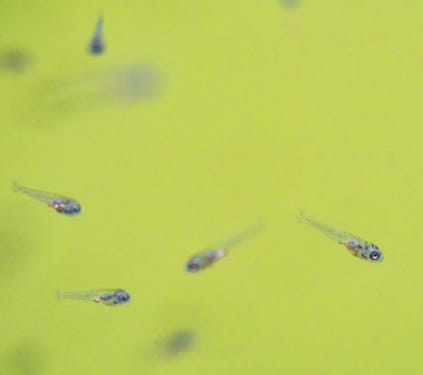
During early life, they feed on microscopic plankton. It’s hard to identify crappie fry at this stage because they take a while to get the distinctive sunfish body shape and color patterns.
What Do Crappie Fish Eggs Look Like?
Crappie fish eggs are dark yellow/orange in color and often referred to as a roe-sac.
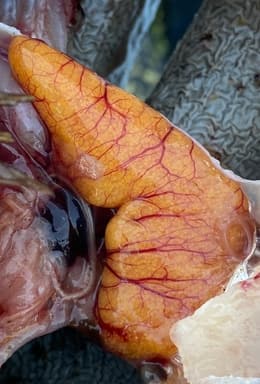
When crappie spawn, the female crappie can lay huge amounts of eggs, numbering in the tens of thousands in a nesting area.
A male then comes along and fertilizes the eggs and when the fry hatch, they move into the weeds for protection as they grow and mature.
About The Name Crappie Fish
The somewhat unfortunate common name for crappie comes from the French-Canadian Word crapet, meaning sunfish.
Crappie are a member of the sunfish family and consist of two distinct species, black and white crappie.
Both are native throughout much of the Eastern United States and have been widely introduced throughout the country.
Black crappie are more predominant in the southern parts of the range, with the reverse true in the north, but you’ll commonly find one where you find the other.
They’re both members of the genus Pomoxis, which means “sharp cover” and refers to their spined gill covers.
See Also: The BEST Crappie Baits To Catch Slabs All Year Long!
If you haven’t guessed yet, I love fishing and everything about it!
To learn more about why I started Panfish Nation, visit the About page and follow along on Social Media:


Download a copy of my FREE Lure Color Selection Chart & Knot Guide!
Stay up to date with fishing reports, tackle reviews, industry news, and much more! We respect your privacy, unsubscribe at any time.
Related Posts
- Crazy Facts About the World Record Crappie
- What Size Hooks for Smallmouth Bass? Quick Guide
- Large and in Charge-Mouth: 10 of the Best Bass Lures of All Time (And Where to Buy Them)
- Emperor of the Sun(fish): What You Need to Know About the World Record Bluegill
- Coppernose Bluegills: How They’re Different from Common Bluegill
- Bluegill vs Brim: Differences & Terminology, Explained!




